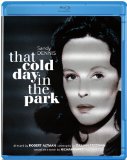| Reviews & Columns |
|
Reviews DVD TV on DVD Blu-ray 4K UHD International DVDs In Theaters Reviews by Studio Video Games Features Collector Series DVDs Easter Egg Database Interviews DVD Talk Radio Feature Articles Columns Anime Talk DVD Savant Horror DVDs The M.O.D. Squad Art House HD Talk Silent DVD
|
DVD Talk Forum |
|
|
| Resources |
|
DVD Price Search Customer Service #'s RCE Info Links |
|
Columns
|
|
|
That Cold Day in the Park
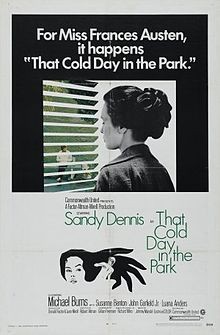
Please Note: The images used here are taken from promotional materials, not the Blu-ray edition of the film under review.
When it comes to Robert Altman, I'm an iconoclast's iconoclast: My favorite work by that reliably rebellious, hit-or-miss, sometimes truly great American independent-film (or, at least, independent-spirited film) godfather isn't one of his popular hits (The Player) or rightly famous cinephile's-pick classics (Nashville), but his previously too-long-overlooked 3 Women. And now that I've seen his hazily evocative 1969 film That Cold Day in the Park, I can say with some assurance that it's much better than the one that followed, Altman's popular breakthrough, the overrated M*A*S*H* (many, many of his other, less-popular films are markedly more interesting and accomplished than M*A*S*H*, too; simultaneous box-office and artistic success were not very frequently to be for this adventurous film artist). That Cold Day in the Park is actually much more typical of Altman in general than his famous Korean war movie, and a striking opening salvo in a strain of soft-edged ambiguity that would weave its way through the rest of his work, most notably in the films about women. That blissfully tragic moment at the end of McCabe and Mrs. Miller, where we unexpectedly cut to an extreme close-up on Mrs. Miller's opium pipe so that it becomes the entire screen world (and that's what we, along with the character, are left with) is more of a continuation of -- has more of a connection with -- what Altman was up to in That Cold Day in the Park than anything in M*A*S*H*. Here, we find Altman's trademark languorously roaming camera and audio-visual layerings already in full flight, as well as his insatiably curious, queasily unpredictable visual/narrative style that always seems to be in the act of peeking around a corner; his intriguing and rich off-center approach to his people and their situations; and that taste for the undecided, in-between, fluid corners of life that reached its peak in parts of Mrs. Miller and was even more full-bloodedly present in 1972's Images and the aforementioned masterpiece 3 Women.
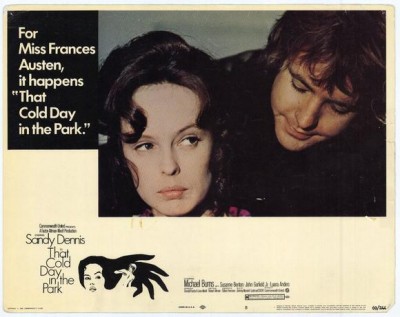
For this first exploration, Altman takes off from a novel by Peter Miles about a repressed young woman who takes in a handsome, apparently homeless young man out of pity but begins to treat him like a prisoner (in a sort of gender reversal of William Wyler's The Collector); he's a disturbingly arousing object of desire to be locked up until she can bring herself out of her binding inhibition and have him. Altman works with his stars Sandy Dennis (the stage legend and supporting actress from Who's Afraid of Virginia Woolf? who does what very well may be her finest-ever work here) and former prolific TV child actor Michael Burns, shooting the story against the backdrop of chilly Vancouver, B.C., the ambiance of which is significant; unlike most other Vancouver-shot productions, Altman doesn't just exploit the cheapness of filming there and make the place stand in for some other town, but instead embraces it as what it is, recognizing its status as Canada's Left Coast answer to San Francisco -- the summer-of-love quality of its places and people the perfectly sexually and medicinally-liberated contrast to the Dennis character's buttoned-up life -- as in fortuitously perfect keeping with what That Cold Day in the Park is about. Equally significant are the characters' names, or lack thereof: Dennis, her hair done up in a prim bun and her quasi-British elocution ringing in well-articulated echoes through her spacious and elegant flat, goes by the bookish-drawing-room moniker Frances Austen, while the young blond man who catches her eye as she shuts the blinds in preparation for a dull bourgeois dinner party featuring her dull, proper doctor fiancé and some even more tiresome older relatives, is never named. Frances assumes that the boy is homeless (this turns out to be only half-true), and, despite her guests' mocking her meek expressions of sympathy, she ignores their advice and invites him in after they finally leave, his apparent starving appetite, nonchalantly immodest doffing of his soaked clothes and all-around penchant for uninhibited nudity, and refusal to speak arousing her interest and eliciting her invitation that he stay the night...in a separate bedroom, of course.
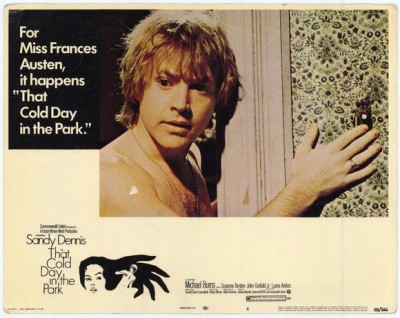
The young man turns out to be just a halfheartedly drifting suburban boy who pops in and out of his folks' house as he pleases, playing hippie along with a sexually-active-and-loving-it sister (Susanne Benton) whom he invites into Frances's house for a peek and a laugh at his lush new digs (the sister throws into further relief the anachronistic self-imprisonment of Frances's sexuality). But the stakes are very high -- life-or-death, as it turns out -- for the repressed Frances, and it's this disconnect between casualness and urgency that the film explores for a mounting tension that finally releases in a drastic climax, with a disturbing yet deeply touching conclusion to Frances's futile plans to free herself through her delayed seduction of this bemused young man, who only meant to string along a generous square. Along the way, the camera (in a fantastically fluid, amazingly expressive technical collaboration between Robert Altman and his DP, the great Laszlo Kovacs (Five Easy Pieces), that's full of beguiling, seemingly near-continuous slow pans and zooms, with shifts in the film's usually shallow focus that create a visual atmosphere at once raw, gauzy-soft, and rife with unexpected, near-hallucinatory detail) follows her along at that steadily, stealthily inquisitive Altman visual tempo as she discreetly locks the boy's door at night and brings him breakfast in the morning (then nails his window shut after she realizes it's his escape route); allows herself the unheard-of luxury of actually becoming playful with him in a game of blind-man's bluff and a feast of hash brownies; and becomes a stone-faced, statue-stiff blank slate at her pre-wedding visit to the gynecologist's, where her fellow patients fill the waiting room with embarrassingly free, New-Woman talk of IUDs and The Pill and variances in male and female anatomy. Frances finally tips into a sort of panicked erotic madness when she discovers, after spilling her heart out to the silent man she hopes will soon be her lover (she's like Bibi Andersson in Persona, becoming ever more talkative and self-disclosing to fill the void left by Liv Ullmann's stubborn silence), that she's been talking to a stuffed-animal dummy left by the boy to lull his captor, leaving him free to roam out in the night in an unrestricted way unimaginable for Frances. What she then does to keep the boy a part of her cloistered life becomes increasingly absurd, desperate, and self-destructive -- a prolonged meltdown throughout which Altman, Kovacs, and Dennis nevertheless sustain that floating equilibrium, that never dispassionate but always calmly accepting taking in of everything by a restless camera eye, that were particular aesthetic attributes that belonged to Altman alone.
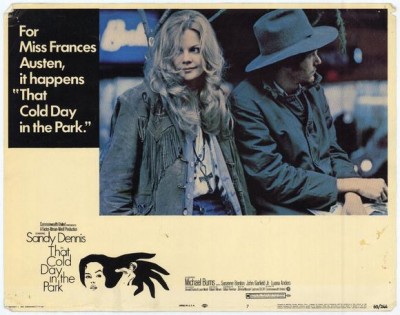
That Cold Day in the Park was an artistic triumph but a financial failure soon erased by bottom-line-obsessed Hollywood history; I'll confess that, until I read the excellent oral biography of Altman by Mitchell Zuckoff, I had complacently assumed that M*A*S*H* was his first feature, and that he simply grew by leaps and bounds from there. But now that I've finally seen it, I can attest that it's decidedly purer Altman than his breakthrough (any fellow fan of the director who also hasn't yet seen it should jump on this Blu-ray, which not only finally makes it widely available but does it full visual justice to boot), revealing that his imaginative, captivating, mood-creating use of the camera was there and bearing glorious fruit from the beginning. Altman was never a quixotic, Cassavetes-like crusader for some platonic ideal of Real Life miraculously captured and conveyed through film; he accepted the artifice inherent to actors, sets, stories, scripts, etc., and then used his camera to probe that artifice in search of whatever capital-T Truth (as opposed to facts or "reality") lies dormant in it -- a process in which, in Altman's sincerely inquisitive hands, the journey, the search, really is as important as the destination or truths we might arrive at. This smart, original, expansive aesthetic philosophy is already on bold display in That Cold Day in the Park, in the way Altman (and, it shouldn't be forgotten, Dennis) intently but somewhat obliquely show you the film's very "normal," very haute-bourgeois woman dealing with the repercussions of what is perhaps her only act of spontaneity ever, bringing out her true existence as a haunted, haunting enigma that no-one who thinks they know her would ever quite suspect. As he would, always with admirable boldness and frequently to great success, do over the vast, diverse array of stories he would subsequently tell us, Altman holds her and her misadventure up to the light for scrutiny, turning them around slowly and letting us catch all those fleeting glints and refractions that enthrall, intrigue, and offer up clues as to what its meaning or significance, its Truth, might be, without ever presuming to make that call on our behalf.
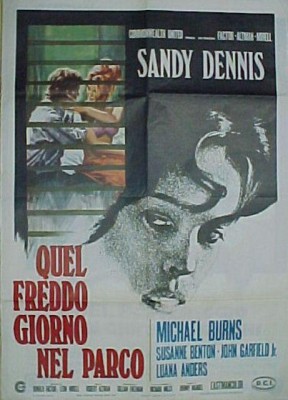
This AVC/MPEG-4, 1080/24p widescreen presentation of the film (at an aspect ratio of 1.78:1, apparently slightly altered from its theatrical exhibition ratio of 1.85:1, though it appears that that may have been a "matted" ratio from the film's original shooting ratio of 1.33:1; in any case, the framing all looks fine here) boasts an encouragingly conscientious transfer that keeps everything remarkably close to the film's period-specific look, the purposely shallow-focused/diffused textures of Lazslo Kovacs's naturalistic lighting and muted-color palette remarkably intact and beautiful in their singular way. There's plenty of healthy grain, indicating no overscrubbing with digital noise reduction, and little to no edge enhancement; it's an altogether nicely authentic, faithful, and film-like experience.
Sound:The DTS-HD Master Audio 1.0 soundtrack faithfully preserves the film's somewhat limited original mono soundtrack. Though the score sounds full and warm, there's an occasional tinniness and distortion to some of the dialogue, which will sound familiar to fans of late-'60s/early-'70s American cinema -- typical deficiencies (at least to Dolby/DTS-trained ears) in the direct-sound recording technology available to moviemakers at the time. There are, however, no apparent flaws in the treatment of the sound during the process of getting it onto Blu-ray; it always fits and sounds right and normal for a film of this style and vintage, regardless of any limitations.
Extras:None, unfortunately (Altman was eternally game for providing audio commentaries for any and all of his films, and if he weren't sadly departed, it's a good bet he would've at least been available for one here).
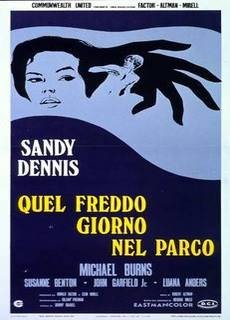
Robert Altman's perennial, eagerly inquisitive desire to explore women characters' murkiest depths (à la Images, 3 Women, and the Mrs. Miller half of McCabe & Mrs. Miller) is already evident and well-developed in an earlier, comparatively little-heard-of, altogether remarkable picture, That Cold Day in the Park. This strangely intimate and intense film, which (after a quickly disowned low-budget sci-fi movie, Countdown, that he made in '67), is for all intents and purposes Altman's true début, his real transition from a long, well-regarded apprenticeship in television to a big-screen directing career as the hyper-observant but loose cinematic storyteller we came to know, recognize, admire, and love over the subsequent decades. With a sure and steady visual sense that glides calmly (making unexpected detours all the while) through the world of the film's main character, the lonely Frances Austen (the never-better Sandy Dennis), Altman enters every corner, shows us every dark place of her externally laconic, internally tortured sexual and emotional repression as she tries to free herself from it through a connection with a strange boy from the park outside her luxury apartment; he achieves this languorous and empathetic but thorough exploration, moreover, without ever forcing or emphasizing matters in such a way as to oversimplify or reduce Frances's experience, or give short shrift to any of its multiple, ambiguous facets. The appearance of real life unfolding in real time in Altman has always been a bit of a sly ruse, brought off through his unusual, often supremely original work with actors and crew, as well as his allowing of scenes to take their own time and work in their own rhythm, however odd. He draws us in on that pretext of realism with good intentions, though; when he's found a story that benefits from the approach, as that of That Cold Day in the Park absolutely does, it allows us to accept, embrace, and become a close fellow-traveler (albeit only for the running time of the movie) in the entirely subjective experience of the character(s), one without its difficult, asymmetrical corners and bumps clumsily rounded off for our easier comprehension and digestion. There may be nothing new under the sun, but the experiences like those of Frances Austen, when related by Altman, his crew, and his cast, become hyper-individuated and fascinating because their inbuilt eccentricities and oddities are paid a unique respect by the sincerely curious filmmaker, who, by forging bravely forward into them and doing a tremendous job of using image and sound to pick up on feelings and behaviors that can't be readily explained or understood (that is to say, human feelings, human behavior), becomes our trusty, steady-handed guide, not just into the story, but into the very textures and details of someone else's dream of life. Highly Recommended.
|
| Popular Reviews |
| Sponsored Links |
|
|
| Sponsored Links |
|
|
| Release List | Reviews | Shop | Newsletter | Forum | DVD Giveaways | Blu-Ray | Advertise |
|
Copyright 2024 DVDTalk.com All Rights Reserved. Legal Info, Privacy Policy, Terms of Use,
Manage Preferences,
Your Privacy Choices | |||||||









